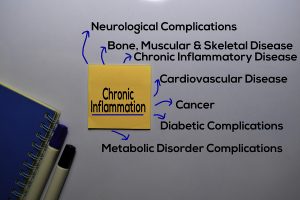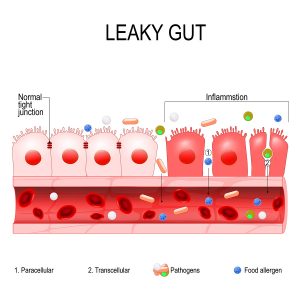We knew since the mid 1990’s that chronic inflammation can cause many diseases. Among these are cancer, hardening of the arteries (atherosclerosis), arthritis, dementia (Alzheimer’s disease), frailty and other degenerative disorders. LifeExtension reviewed this topic in 2019.
Older people often accumulate chronic inflammation, which associates with the aging process. Persistent pain is one of the symptoms that chronic inflammation can cause.
Doctors use tests like the C-reactive protein, hemoglobin A1C, homocysteine and the erythrocyte sedimentation rate to measure chronic inflammation.
When the doctor diagnoses chronic inflammation, it is important to find ways to inhibit it and finally resolve it. Curcumin, ginger and non-steroidal anti-inflammatories are examples of measures that help inhibit inflammation. But it is only lately that scientists have found specialized pro-resolving mediators (SPM) that help to resolve chronic inflammation. They are polyunsaturated fatty acids, which health food stores offer as supplements.
Specialized pro-resolving mediators (SPM)
Researchers isolated several pro-resolving mediators that are metabolites of omega-3 fatty acids. This link discusses an experiment where researchers obtained synovial fluid from arthritis patients who took omega-3 fatty acids. They compared this to synovial fluid from volunteers who also took omega-3 fatty acid supplements. Within 4 weeks there was a big difference for the arthritis patients with higher levels of E- and D-series SPMs in synovial fluid and plasma. Dr. Silverman reviewed the action of SPMs here. He points out that they can be taken as supplements and that they are safe, because they do not have any side effects. Conditions such as asthma, irritable bowel syndrome and various musculoskeletal conditions with chronic inflammation respond very well to SPM supplements. Omega-3 fatty acid supplements (EPA) metabolize into the E-series resolvins. On the other hand, Krill oil with Docosahexaenoic acid (DHA) metabolizes into protectins, maresins and the D-series resolvins.
Three vital tasks of pro-resolving mediators
SPMs fulfill three vital tasks, called remove, restore and renew. First, they activate macrophages, which remove dead cells and cellular debris as a result of chronic inflammation. Second, they restore the healthy balance of inflammatory compounds and anti-inflammatory substances. Third, SPMs help renew tissues that were damaged by chronic inflammation.
Some examples where SPM’s were helpful resolving inflammation in health conditions
- Alzheimer’s disease patients had reduced SPMs in cerebrospinal fluid of living patients and in the hippocampus of corpses who had Alzheimer’s disease.
- A research group showed that defective SPM resolution can be responsible for missing resolution of atheromatous plaques in arteries. This leads to more and more hardening of arteries until a heart attack or stroke occurs.
- With obesity or metabolic syndrome insulin resistance develops. Researchers found that certain SPM’s are missing in obesity, which causes chronic inflammation. However, they also found that precursors of SPMs such as 17-hydroxydocosahexaenoic acid (17-HDHA) can serve as a novel treatment agent to treat obesity-related complications.
Newer studies about SPMs
- 62 patients with knee osteoarthritis had the precursor of resolvins, 17-HDHA tested in the blood. Compared to controls with no arthritis the 17-HDHA level in the arthritis patients was low. When levels of 17-HDHA were high, there was no pain in osteoarthritis patients.
- Chronic periodontitis is a chronic inflammatory condition in the mouth. In a rabbit model this condition was cured with resolvin E1 derived from omega-3 fatty acids.
- Delayed wound healing is typical for type 2 diabetes. In a mouse model with diabetic mice researchers inflicted skin wounds on mice. Subsequently they showed that with resolvins mice wounds healed much faster than in control mice.
- Chronic kidney failure, liver impairment, diabetes, obesity and coronary heart disease showed abnormalities in the SPM system in humans. Potentially they will be healed with the help of resolvins or their precursors, which includes the omega-3 fatty acids EPA and DHA.
Conclusion
New compounds have been detected that derive from the omega-3 fatty acids EPA and DHA. They have the name specialized pro-resolving mediators (SPM). Included are the resolvins D1 and D2, the resolvins E1, E2 and E3 as well as the precursors 18-hydroxyeicosapentaenoic acid (18-HEPE) and 17-hydroxydocosahexaenoic acid (17-HDHA). The function of these compounds is to stimulate macrophages to clean up areas of chronic inflammation and remove cell debris and injured cells that cannot survive. While anti-inflammatories like ginger and curcumin only tone down the inflammation, SPMs help to resolve chronic inflammation. Various chronic clinical conditions were identified as being due to chronic inflammation. Chronic kidney failure, liver impairment, diabetes, obesity and coronary heart disease showed abnormalities in the SPM system. We may soon see alternative approaches treating these conditions with specialized pro-resolving mediators.















